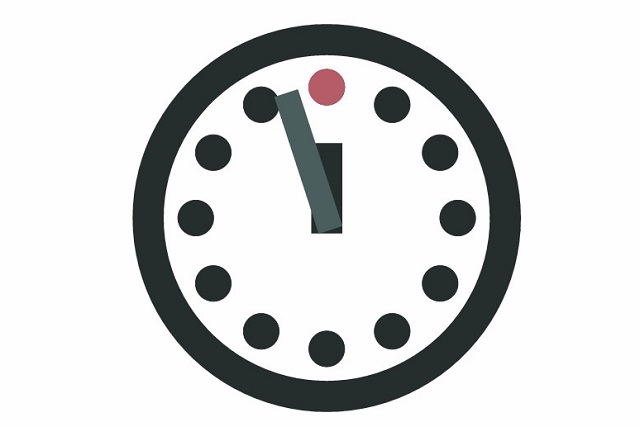Walking after midnight: thinking beyond the Doomsday Clock
Posted By
Rod Lyon
on February 8, 2016 @ 14:30

In 2016 we live in a comparatively peaceful world. No great power is at war with another. Even middle-power conflict is absent: no Iran–Iraq war with chemical weapons being tossed about, for example. Wars can certainly be found, primarily in the broken states of the Middle East. But most of those don’t appear to be a harbinger of doomsday. In brief, while the world’s strategic environment probably can’t be described as benign, it does seem to be manageable. We’re not standing on the brink of an abyss.
But watchers of the Doomsday Clock would be hard pressed to find much evidence of that manageable global order. The clock is meant to symbolise the countdown to global catastrophe—predominantly from nuclear war but nowadays encompassing threats from climate change and new biological technologies. Those crises are described as ‘existential’—as threatening the very existence of civilisation. Keepers of the clock, the Bulletin of Atomic Scientists, recently made their latest determination to leave the hands unchanged. That means it remains set at three minutes to midnight. Newsweek covered the event with an article titled ‘Apocalypse soon’. And visitors to the Bulletin’s website are invited to cast their votes on whether the clock should be adjusted by a minute or two in either direction.
The clock’s been around since 1947. For much of the 1950s it was set at two minutes to midnight, while the US and the USSR raced to build nuclear arsenals and engaged in a competition to see who could build the biggest hydrogen bomb. And for a few years in the mid-1980s, the clock was set at three minutes to midnight, symbolising the tensions in the superpower nuclear balance. The immediate post-Cold War years saw the clock wound back to 17 minutes to midnight, but adjustments since have, by and large, been towards smaller numbers. Obviously, it’s difficult to sustain a sense of urgency if the hands are even a quarter of an hour from midnight.
At this point, it’s hard to know what might see a major resetting of the clock. Nuclear disarmament might see it set back a few minutes, I suppose. But realistically you’d have to make allowance for the possibility of reconstitution of nuclear arsenals during a crisis—which I think could easily be more dangerous territory than where we are now. For one thing, there’s no guarantee that reconstitution would occur at an even, balanced rate across key geopolitical fulcra. Repeated crossing of the bridge between a nuclear and a non-nuclear world is a recipe for disaster if ever I saw one. Still, that’s not where we are now.
At least in relation to current nuclear dangers, I’m puzzled by what it is that’s supposed to happen at midnight? Do we reach midnight with the first nuclear detonation in a war? If so, what does 1am look like? Some of the most interesting and neglected questions in nuclear strategy concern what happens after deterrence fails. But a failure of deterrence needn’t mean ‘doomsday’—or, at least, not doomsday in the sense that films and computer games often suggest.
Naturally, we should be interested in slowing, halting and reversing any slide towards the use of nuclear weapons. But if we do end up crossing the threshold, the answer’s not to throw up our hands and resign ourselves to extinction. Rather, we need to have a meaningful set of strategic choices after midnight—including options for slowing, halting and reversing further nuclear use on the day after. Obsessing about midnight doesn’t help us develop those.
Last year graphic designer Michael Bierut described the Doomsday Clock as ‘the most powerful piece of information design of the 20th century’. Visually, the clock’s simple and arresting—albeit an analogue image in a digital age. (Future generations might struggle to read it, just as they now struggle to comprehend pounds, shillings and pence.) But I’m dubious about how much ‘information’ it actually conveys. I’m not convinced we’re on the verge of extinction, and the idea that ‘the end is nigh’ is neither new nor especially useful. The clock’s best days now lie behind it. I vote for turning it off.
Rod Lyon is a fellow at ASPI. Edited image courtesy of Flickr user ChCariou.
Article printed from The Strategist: https://www.aspistrategist.org.au
URL to article: https://www.aspistrategist.org.au/walking-after-midnight-thinking-beyond-the-doomsday-clock/
[1] Image: http://www.aspistrategist.org.au/wp-content/uploads/2016/02/24732183686_f2de8970ea_b.jpg
[2] made their latest determination: http://thebulletin.org/press-release/doomsday-clock-hands-remain-unchanged-despite-iran-deal-and-paris-talks9122
[3] an article: http://www.newsweek.com/doomsday-clock-be-moved-closer-midnight-419788
[4] described the Doomsday Clock: http://www.theatlantic.com/entertainment/archive/2015/11/doomsday-clock-michael-bierut-design/412936/
 Print This Post
Print This Post